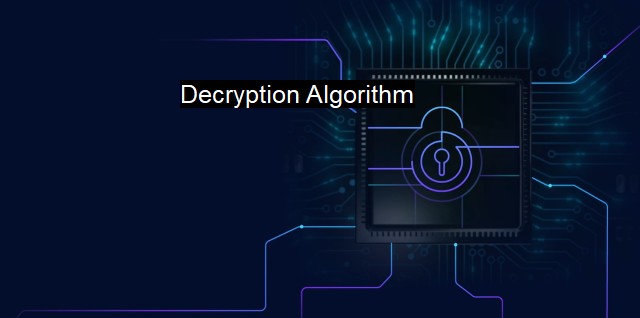What is Decryption Algorithm?
Cybersecurity and the Vital Role of Decryption Algorithms: Unlocking Encrypted Data to Combat Ransomware and Malware Attacks
Decryption Algorithm is a crucial concept in the realm of cybersecurity and antivirus. it is a software mechanism used to access encrypted, or ciphered, information without having the separate decryption key readily available. Simply put, encryption refers to the act of encoding information, making it unreadable without accessing a unique key. Thus, a decryption algorithm is the procedure through which that issof encoded data or information in its encrypted design, is transformed back into its original, readable format.Using a decryption algorithm, individuals or systems can reverse engineer the techniques utilized in the encryption process, mirroring the functions that originally encrypted the data, bringing it back to its original, understandable form. They work based on a pre-determined set of rules for processing data. Special codes input the encrypted data into these processes, then the algorithms carry out transformations, calculations, or operations on the input data to generate the output, which is usually the decrypted information.
Decryption algorithms have integration cut across numerous sectors, most notably in domains where data privacy is paramount – finance and banking, military, health, and antivirus program development, to mention a few. They are essential tools for maintaining the confidentiality, integrity, entitlement, and authenticity of information shared across networks, and breaches can cause grave latent threats to individuals and corporate entities.
In the context of cybersecurity and antivirus software, decryption algorithms are essential tools. Antivirus programs often employ decryption algorithms to decode malicious software or harmful files which uses encryption to disguise its activities. They're vital to uncovering and addressing exploits in networks attached to secret keys or symmetric keys encrypted with complicated algorithms.
Viruses and malware today often utilize sophisticated encryption techniques to avoid detection. This is where a decryption algorithm comes into play. By successfully decoding the information encrypted by the virus or malware, the bare code can be analyzed for functionalities that could potentially harm the system it infects. Once the harmful intentions are uncovered, appropriate responses can be implemented to neuter the potential exploits, subsequently bolstering the security infrastructure.
The importance of decryption algorithms in the fight against cybercrimes cannot be overstated. They contribute directly to ensuring the safe transactions of information across networks, preventing unauthorized access to sensitive information. Decryption algorithms detect, flag, and nullify potential security threats and keep the system secure.
a decryption algorithm is essentially the lifesaver in the era of growing malicious activities in the cyberspace. It is both the lock and the key in the context of digital information and cybersecurity, signifying its multidimensional role of encrypting the essential and unlocking the potential threats. Therefore, having a good understanding of how decryption algorithms can be implemented will undeniably contribute immensely to the progress made in achieving safer digital spaces, as can be testified in applications such as antivirus programs. Calculated usage of decryption and encryption techniques will act as a protective blanket over the information being transferred or stored, rendering the effects of any unauthorized entity trying to tamper with this information ineffectual. The field of cybersecurity will only grow complexer, and thereby the role of decryption algorithms will become gradually crucial.

Decryption Algorithm FAQs
What is a decryption algorithm?
A decryption algorithm is a method of decoding encrypted data. It is used to unlock and read data that has been encoded using a specific key or password. In cybersecurity and antivirus, it is used to decrypt malware or other malicious software to understand their functionality and identify potential vulnerabilities.How does a decryption algorithm work?
A decryption algorithm works by applying a mathematical formula to an encrypted message or file. This formula uses the key or password that was used to encrypt the data to reverse the encryption process and reveal the original information. In cybersecurity and antivirus, the algorithm is programmed to identify the key or password used to encrypt malware and use it to decode the malicious file.What are the different types of decryption algorithms?
There are several types of decryption algorithms, including symmetric-key algorithms, public-key algorithms, and hash functions. Symmetric-key algorithms use a single key to both encrypt and decrypt data, while public-key algorithms use two keys, one public and one private, to encode and decode data. Hash functions are used to verify the integrity of data, but they do not actually decrypt the data.Can decryption algorithms be hacked or bypassed?
Decryption algorithms can be hacked or bypassed if the key or password used to encrypt the data is weak or easily guessable. In cybersecurity and antivirus, attackers may attempt to discover the key or password by brute-force attacks or use other methods to bypass the decryption algorithm. However, using strong encryption keys and regularly updating them can make it much harder for attackers to decrypt data.| | A | | | B | | | C | | | D | | | E | | | F | | | G | | | H | | | I | | | J | | | K | | | L | | | M | |
| | N | | | O | | | P | | | Q | | | R | | | S | | | T | | | U | | | V | | | W | | | X | | | Y | | | Z | |
| | 1 | | | 2 | | | 3 | | | 4 | | | 7 | | | 8 | | |||||||